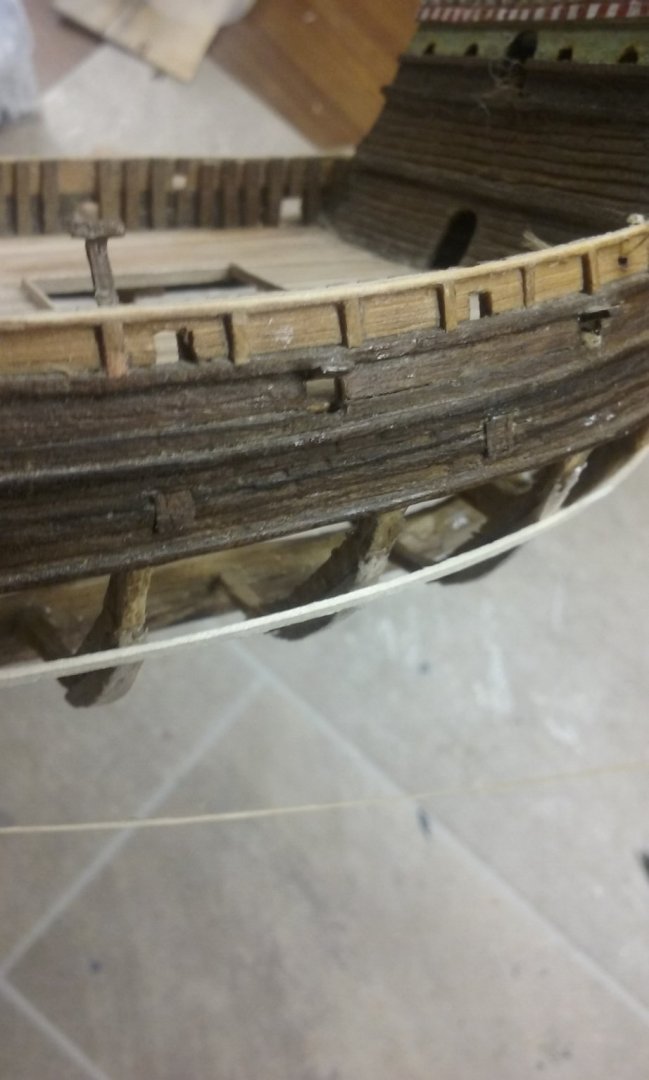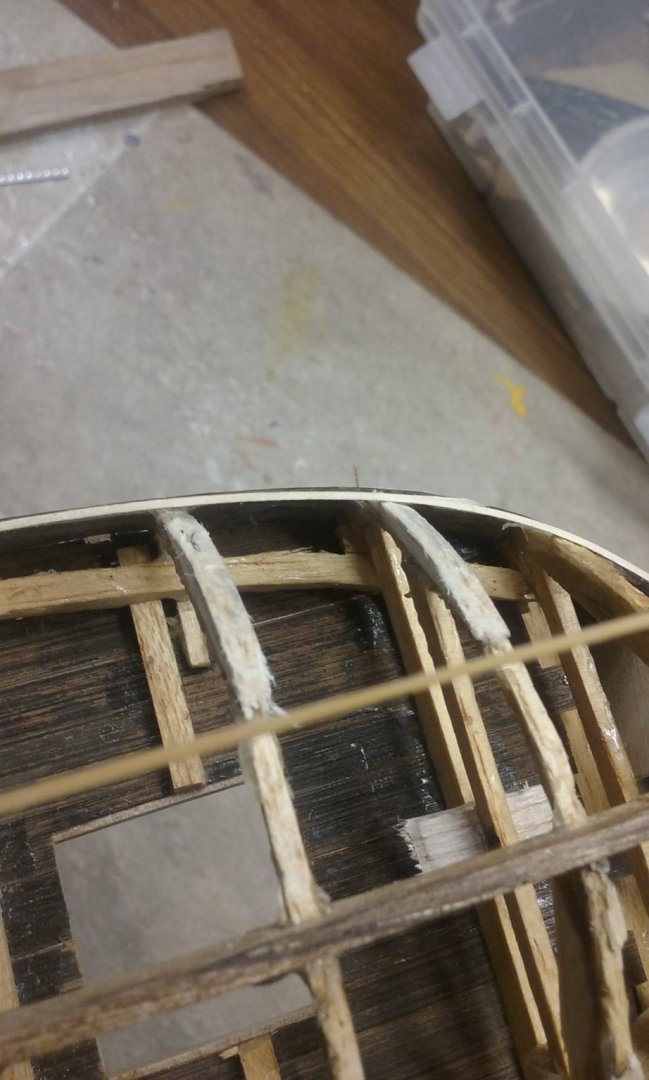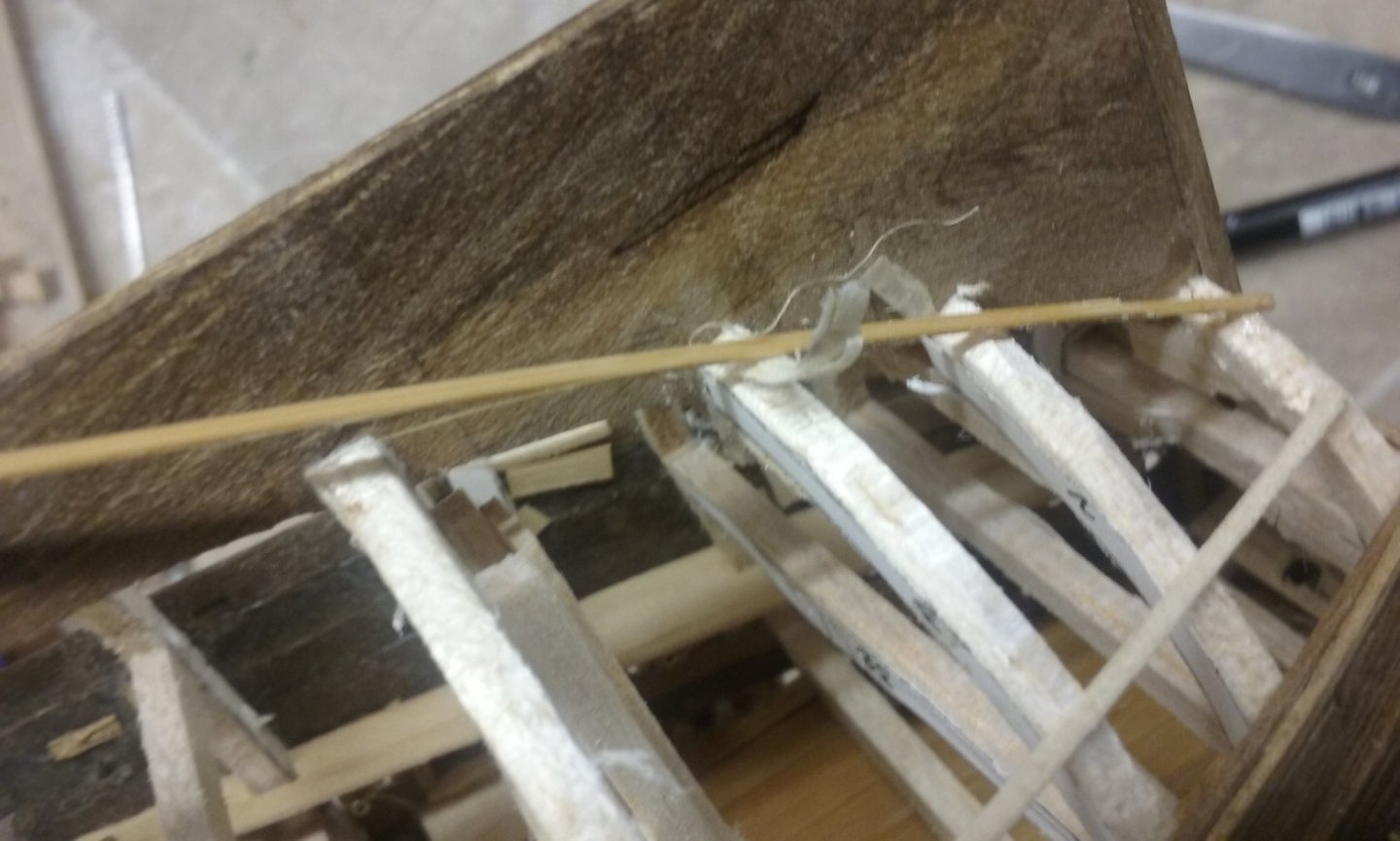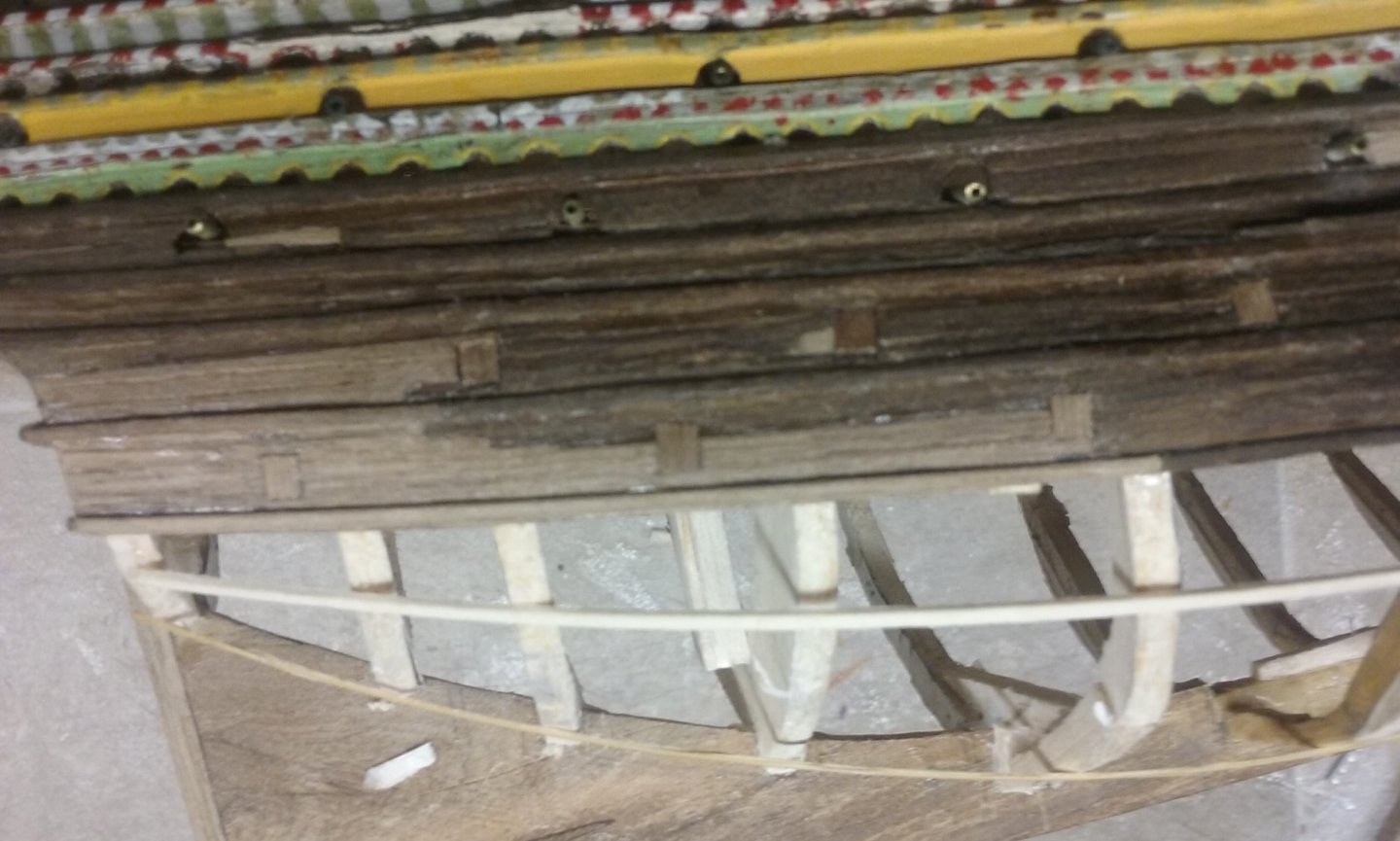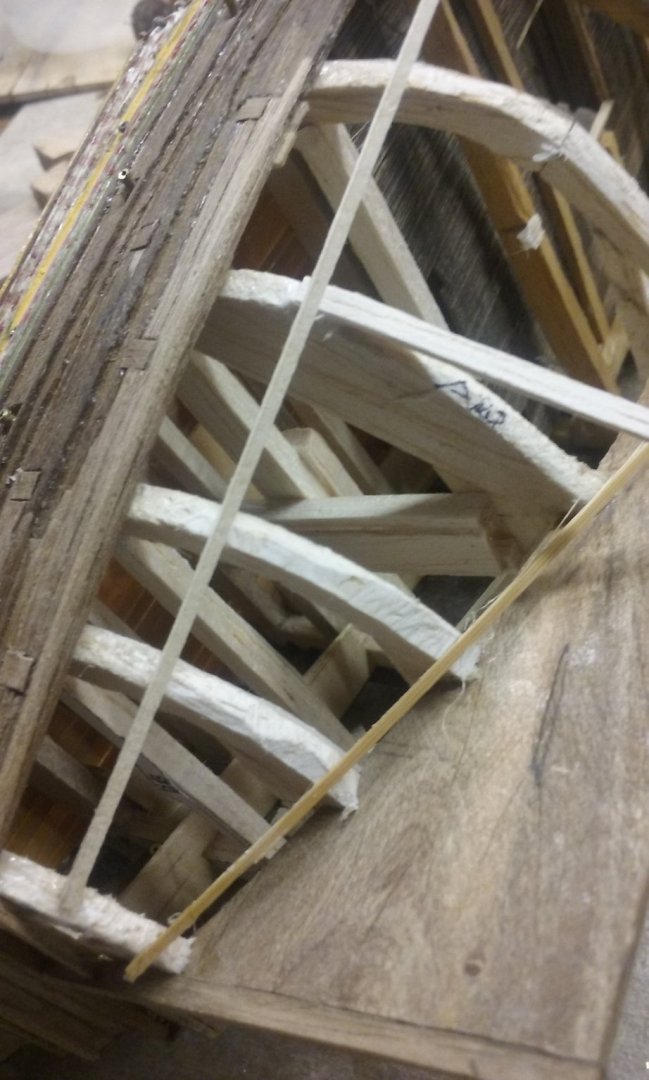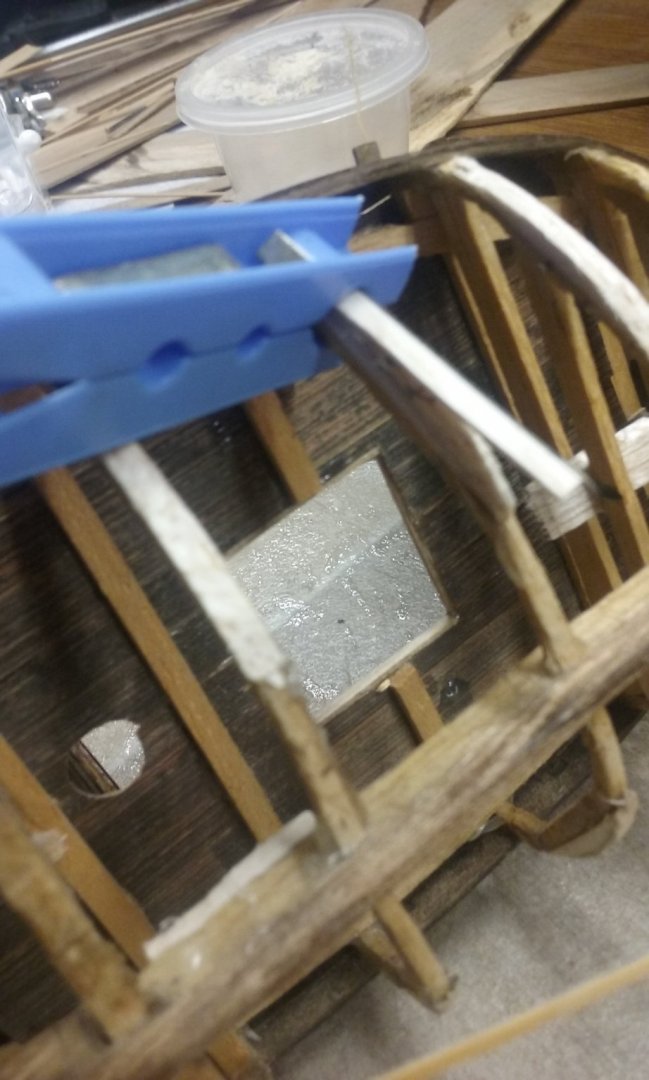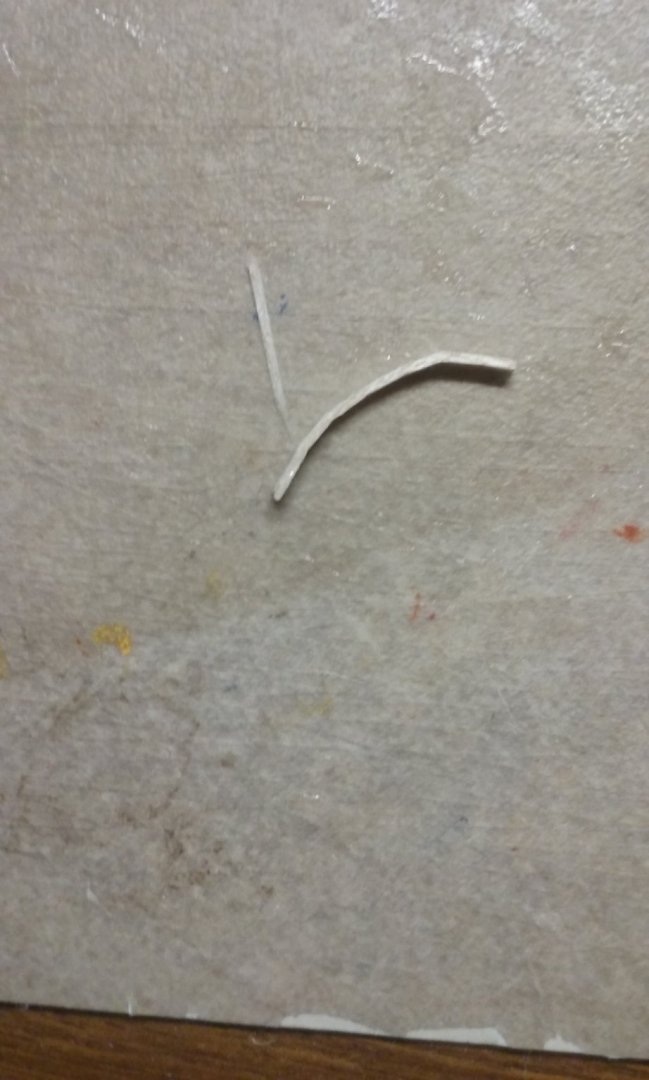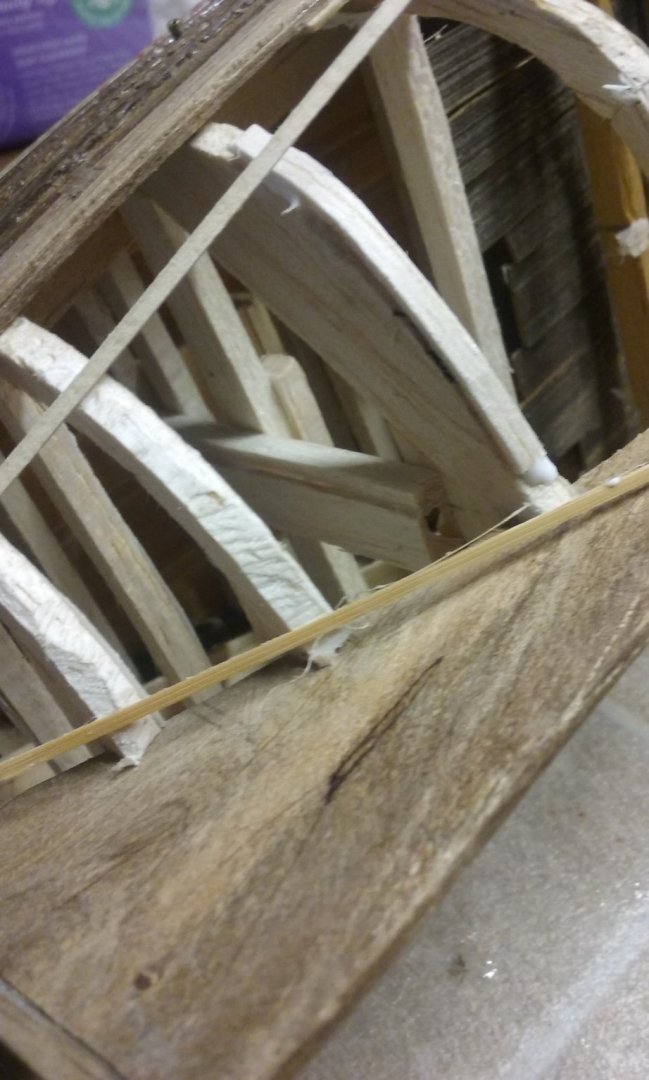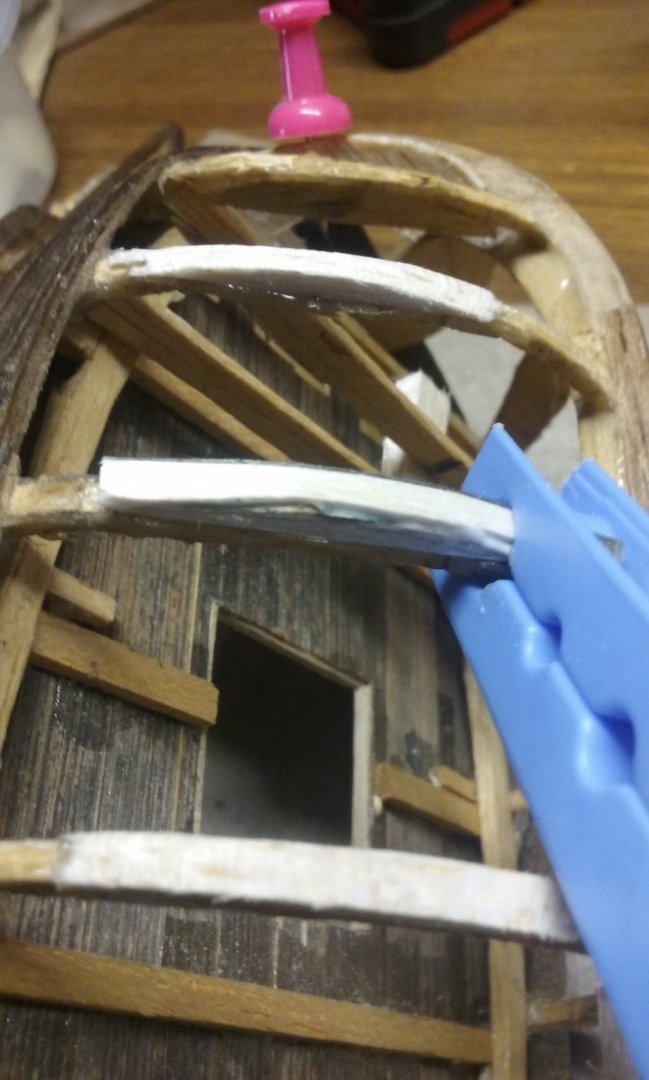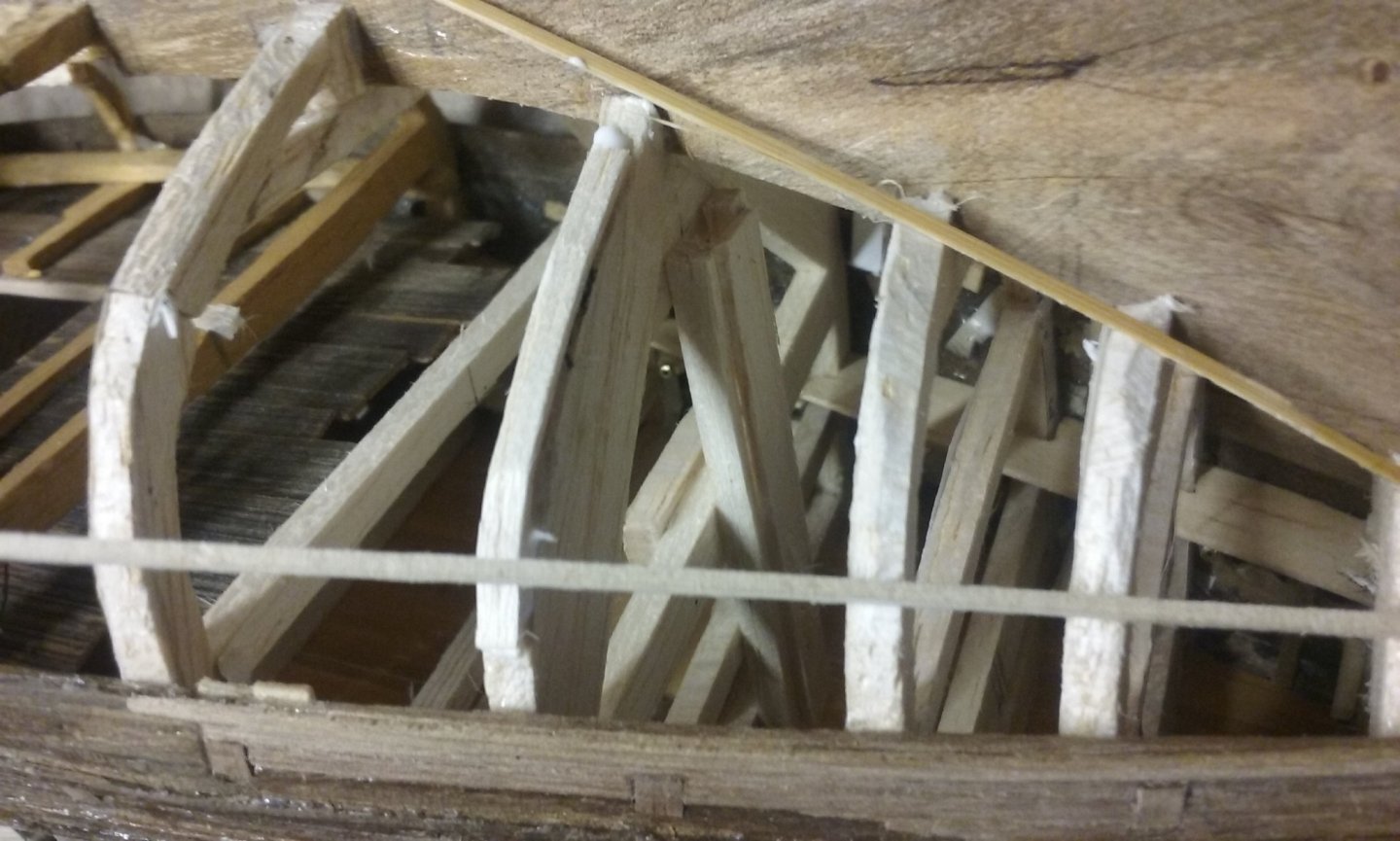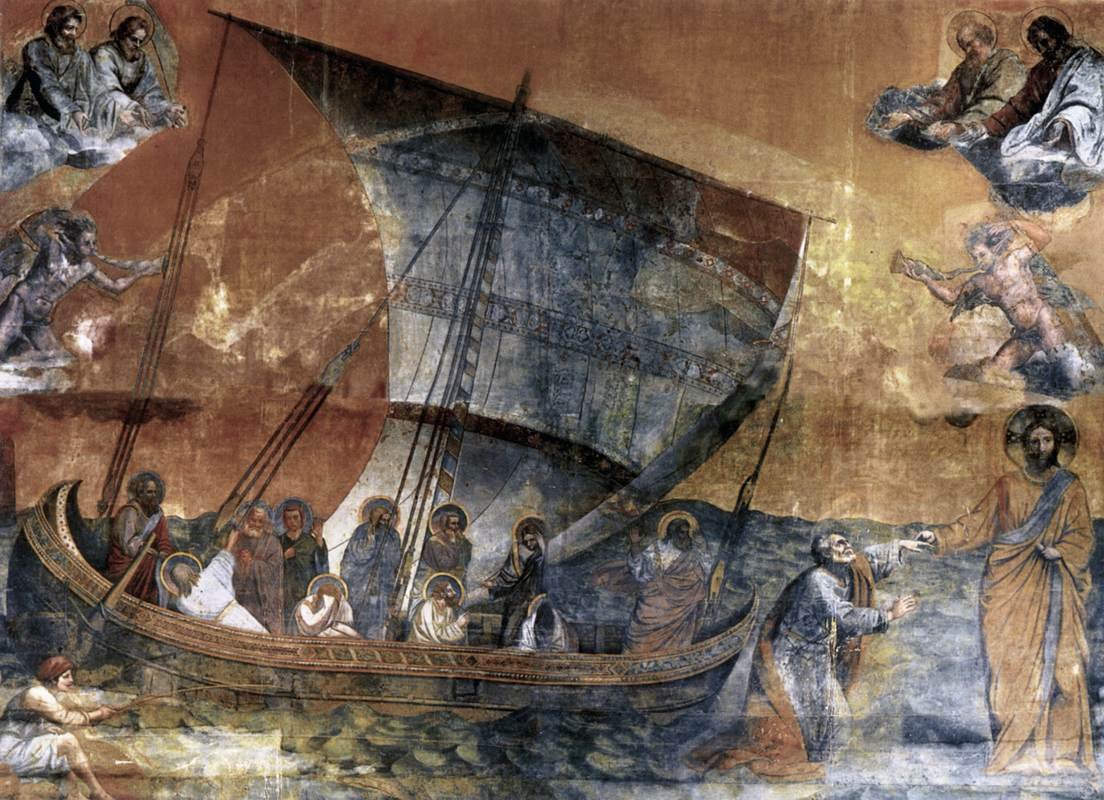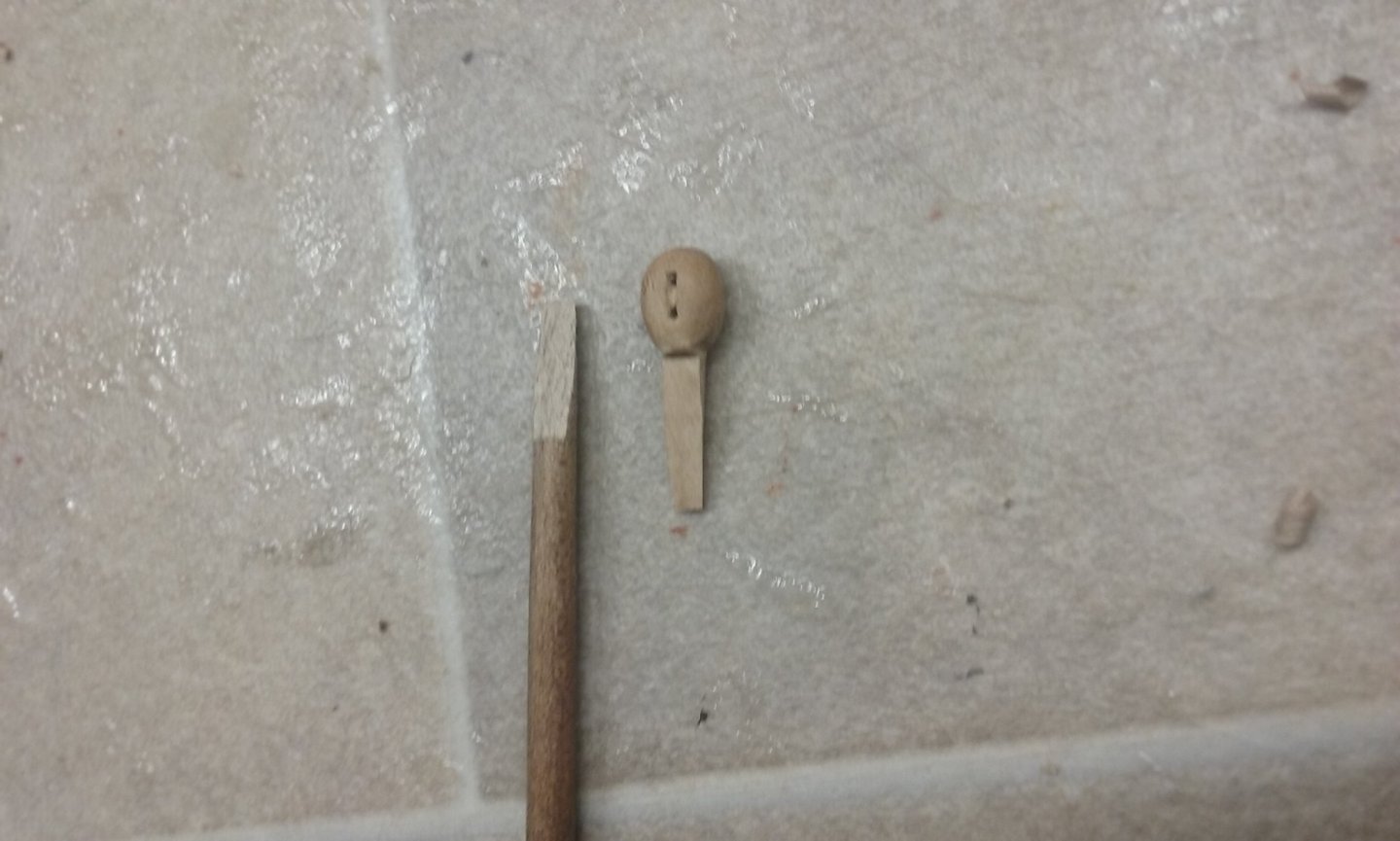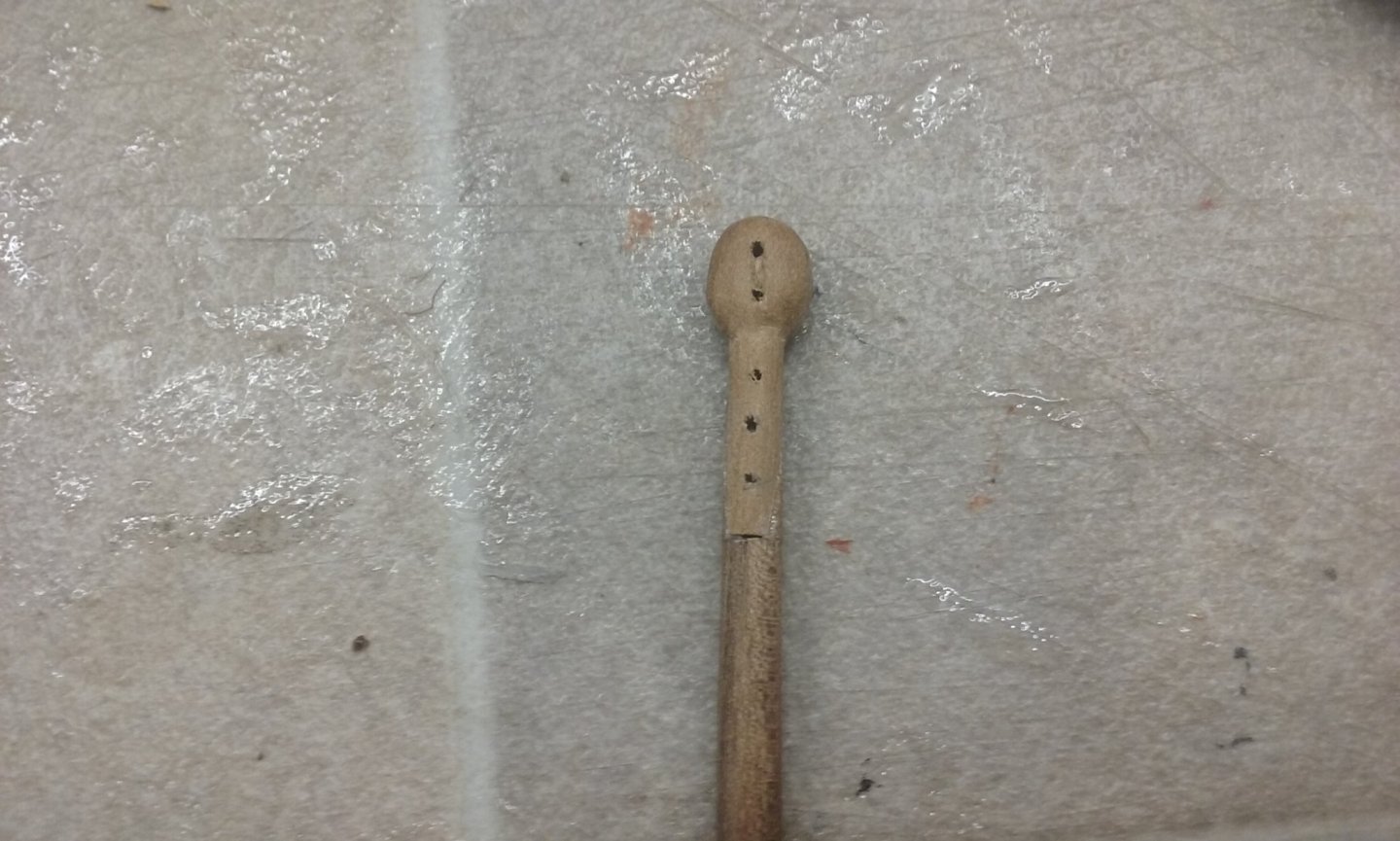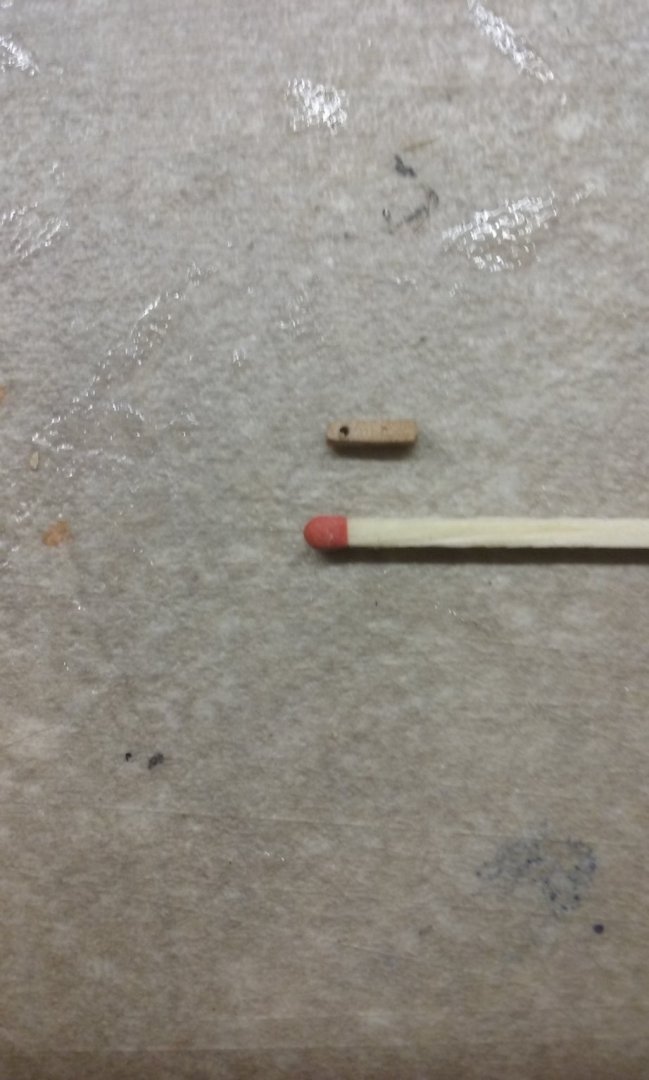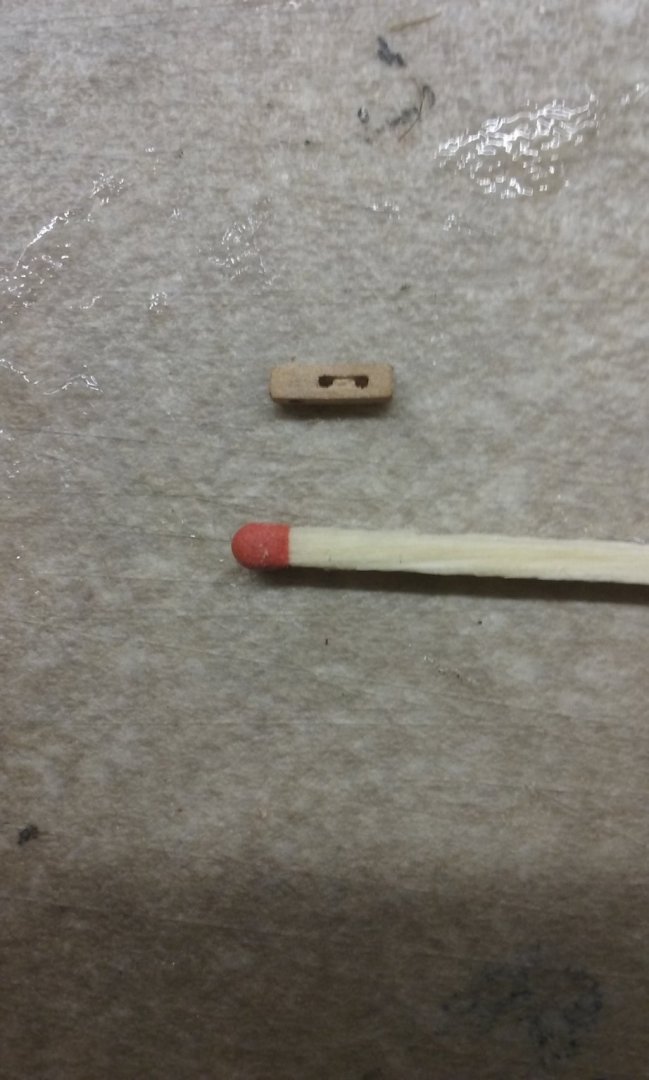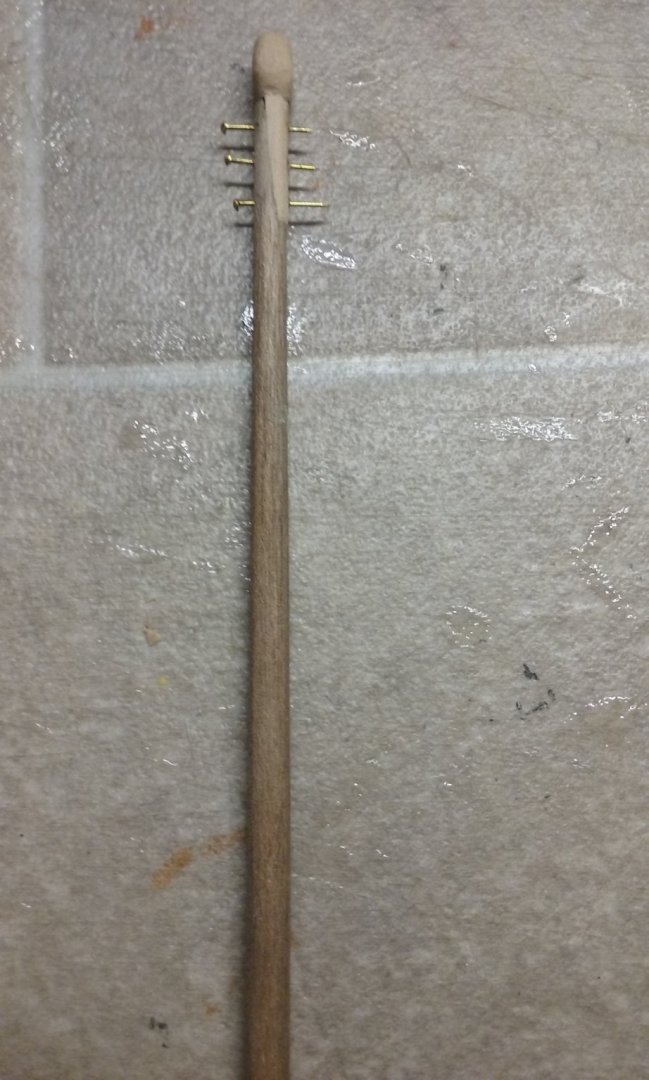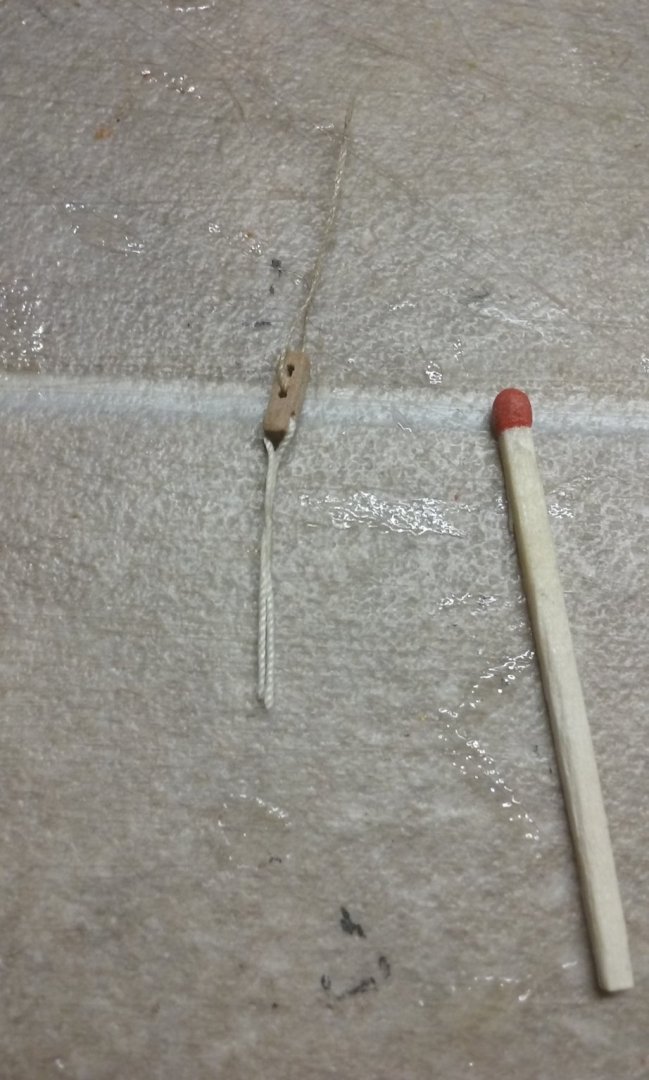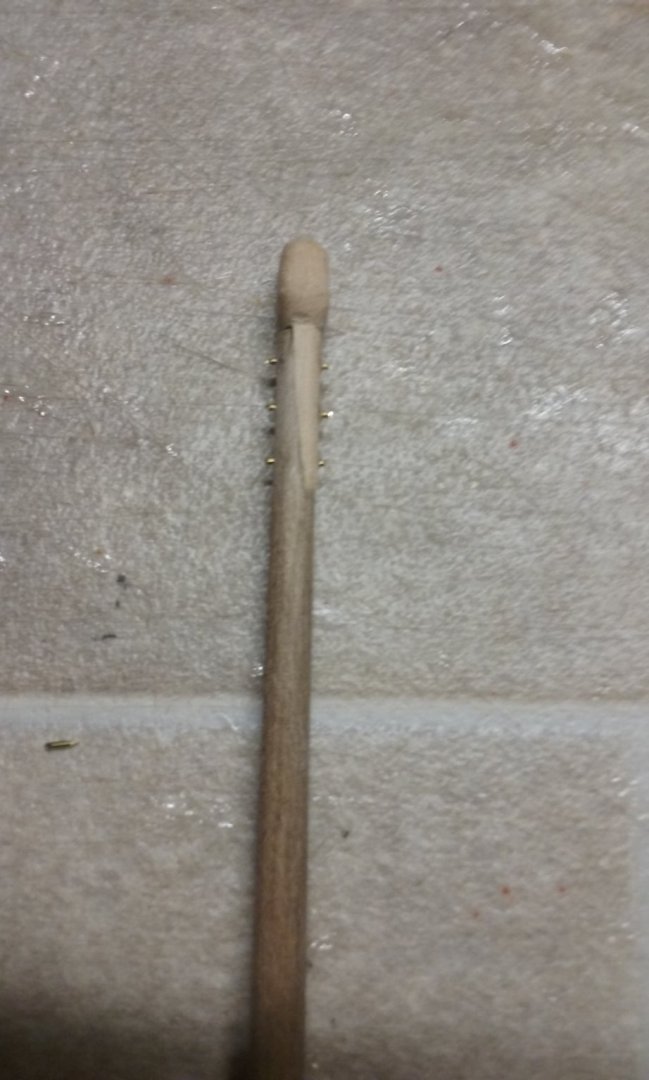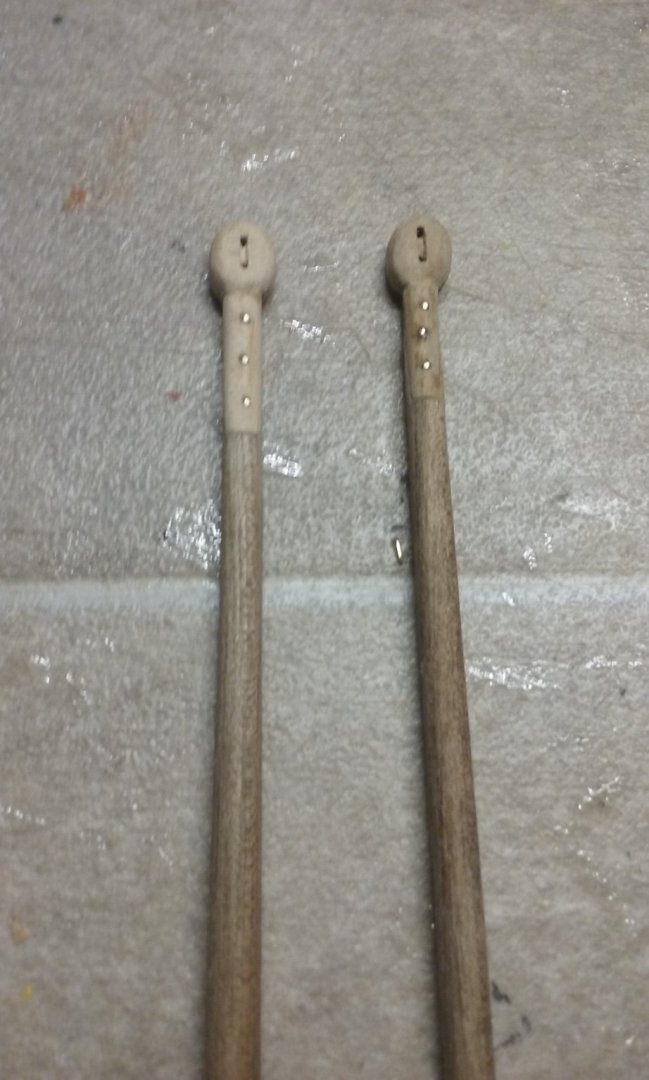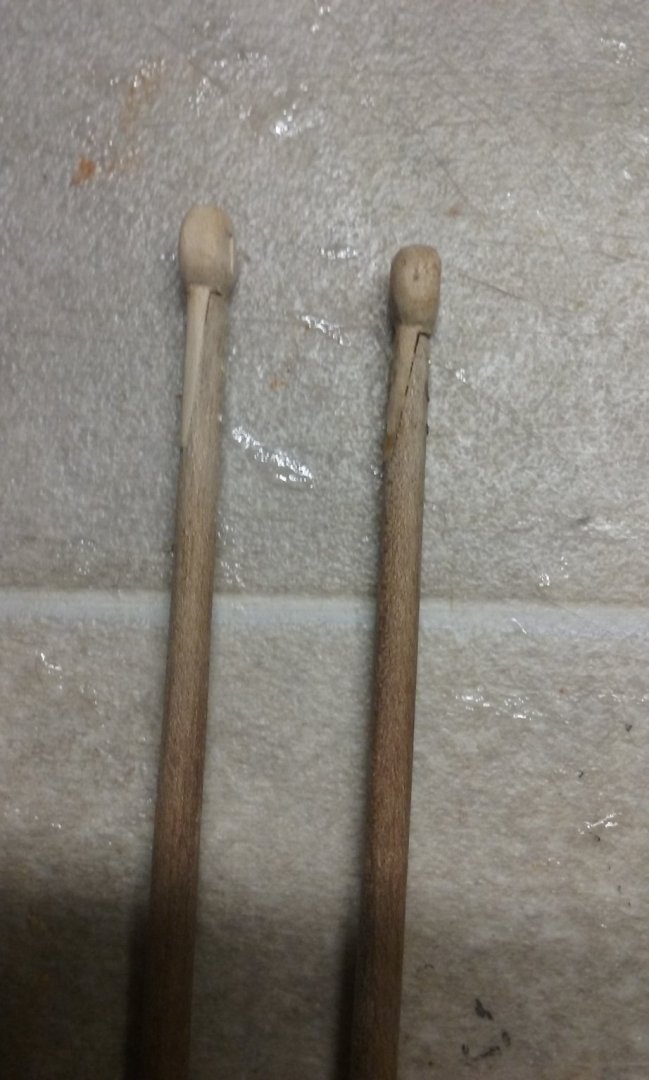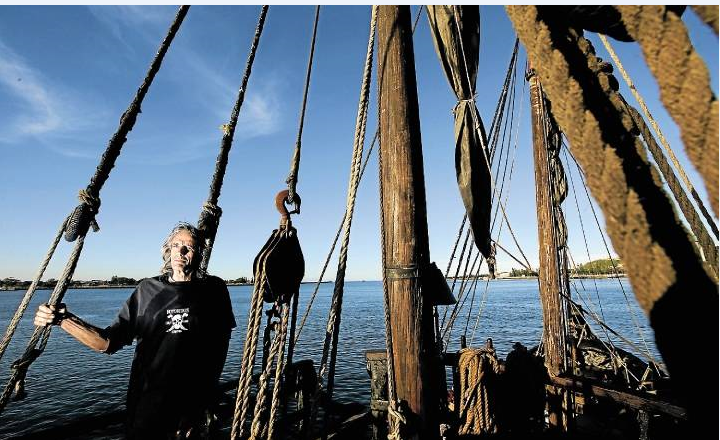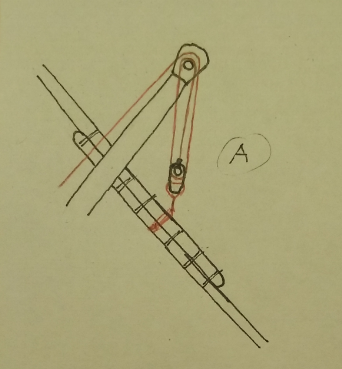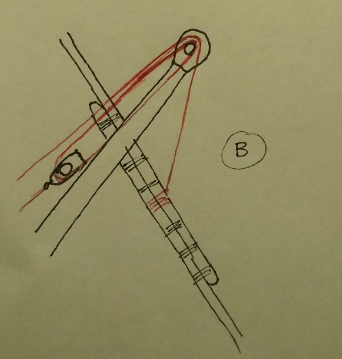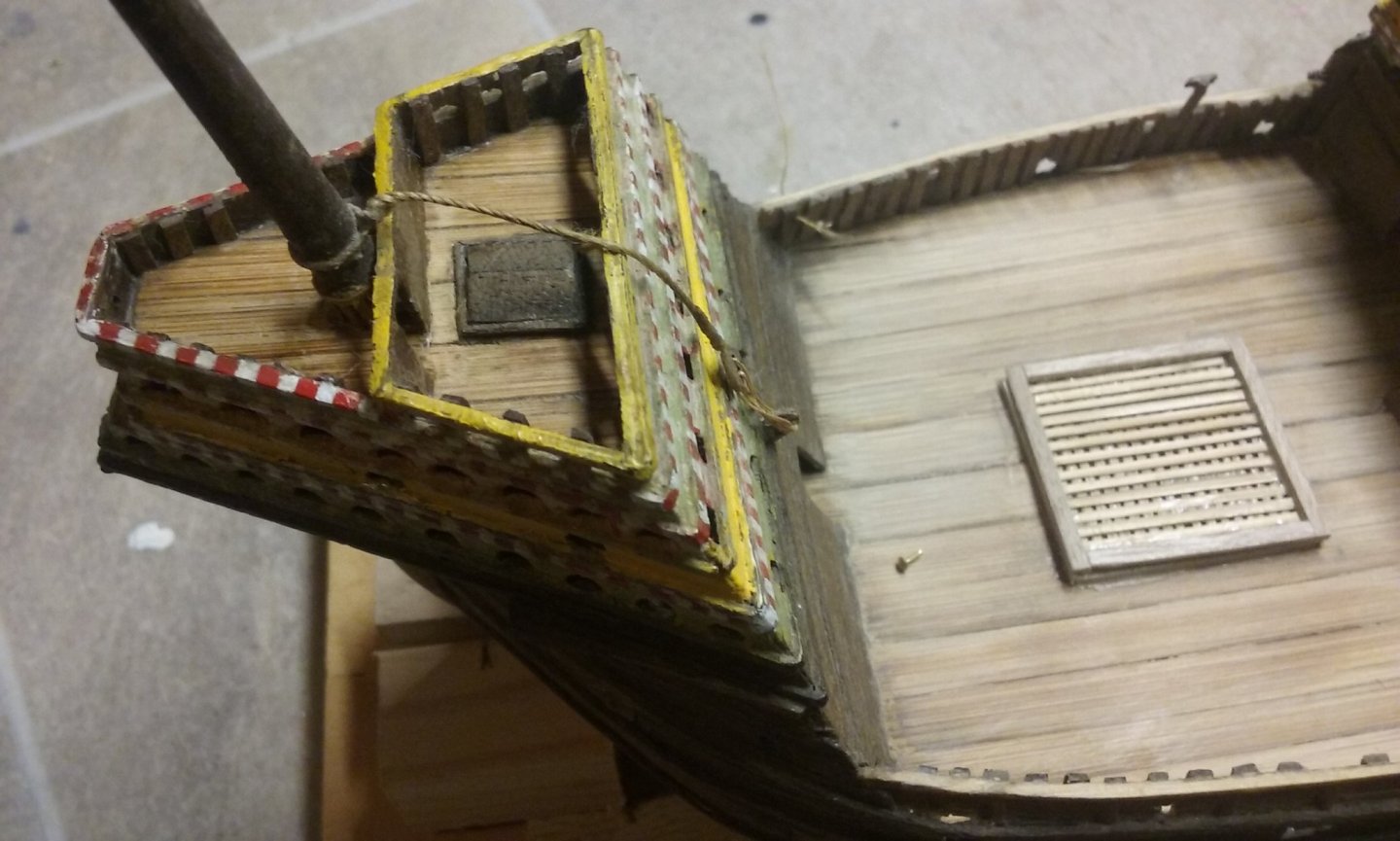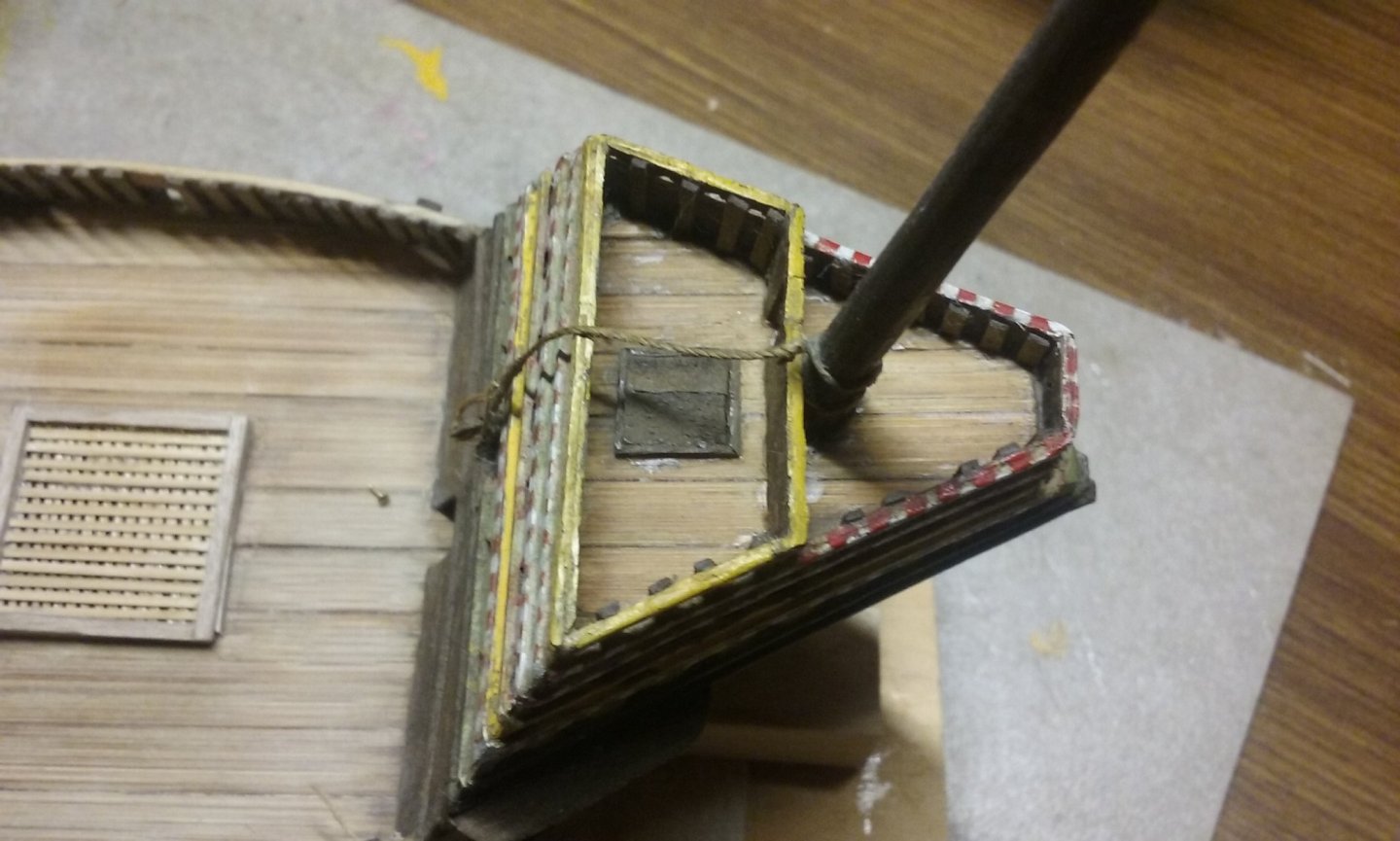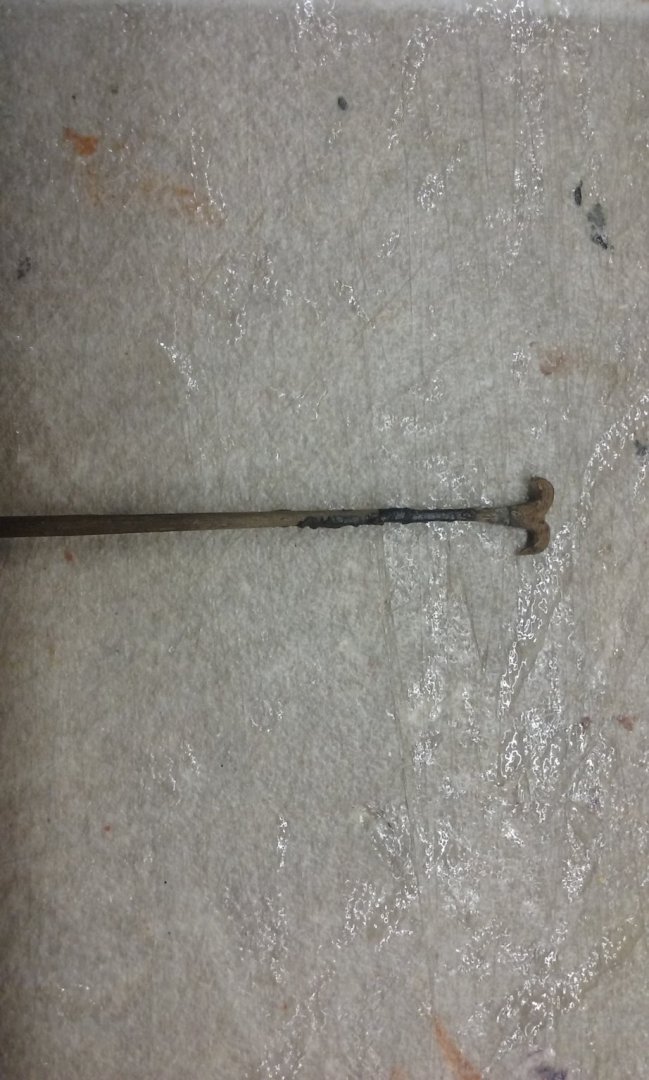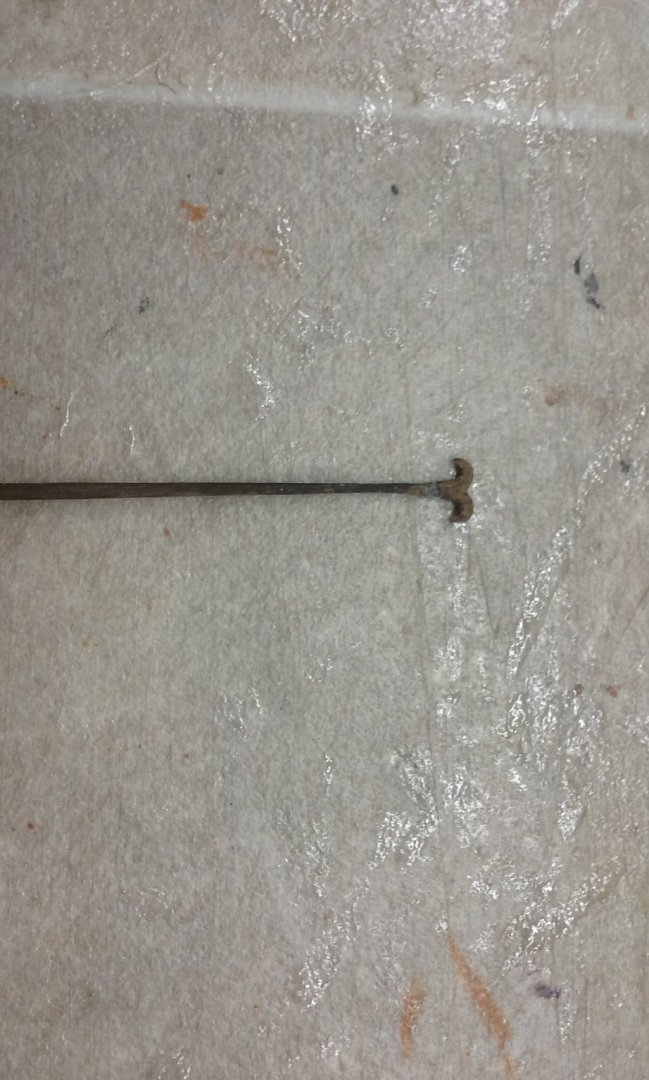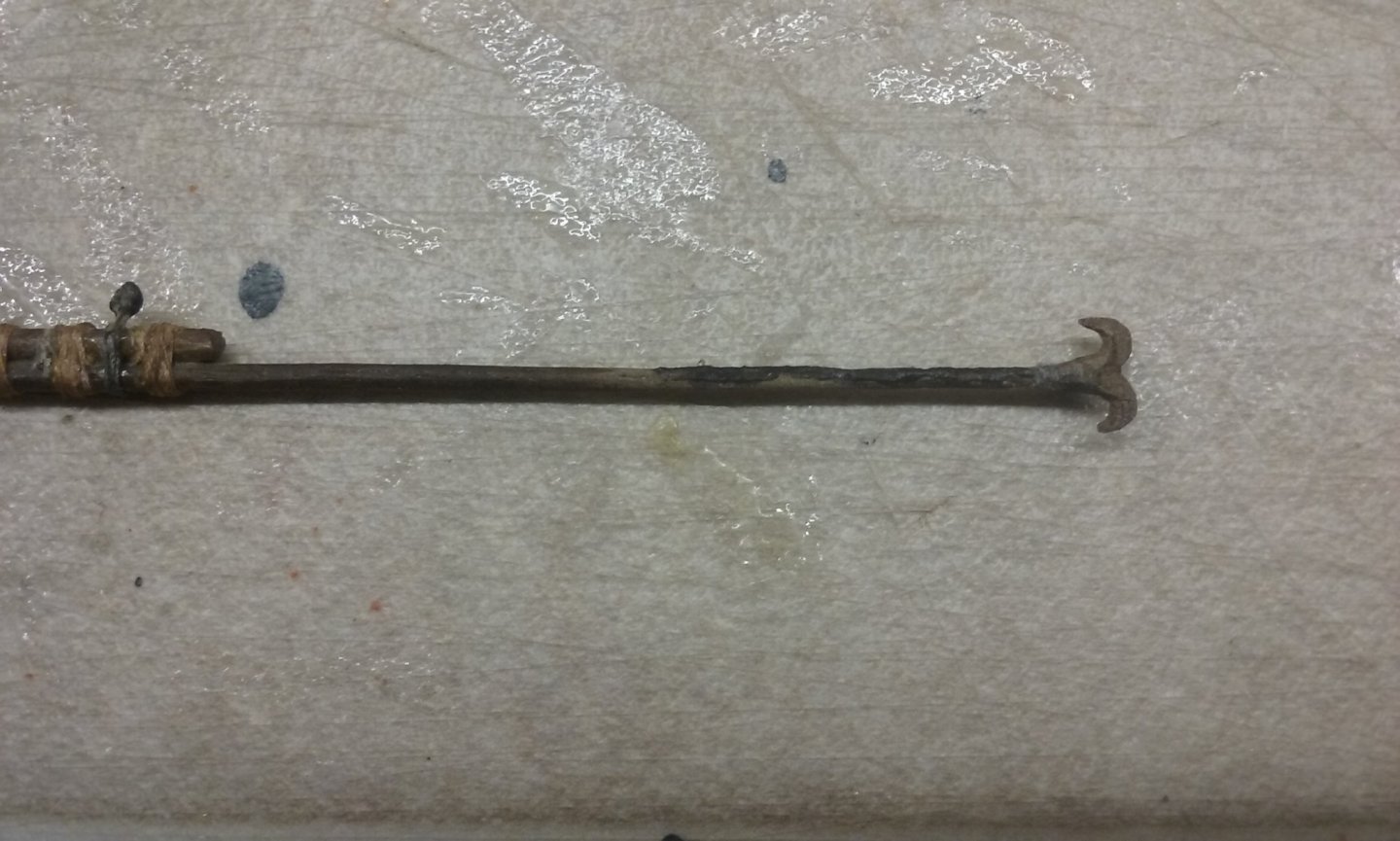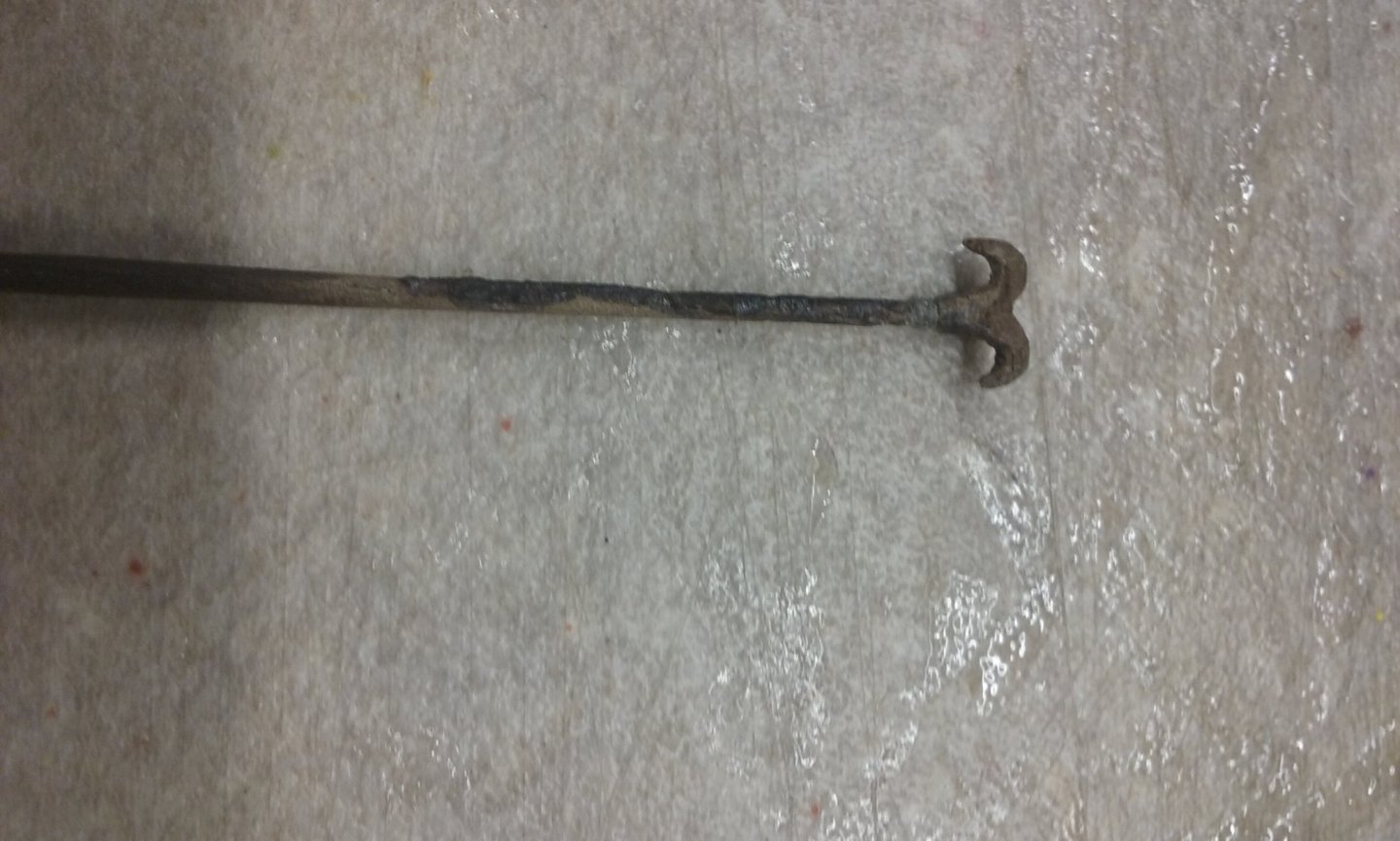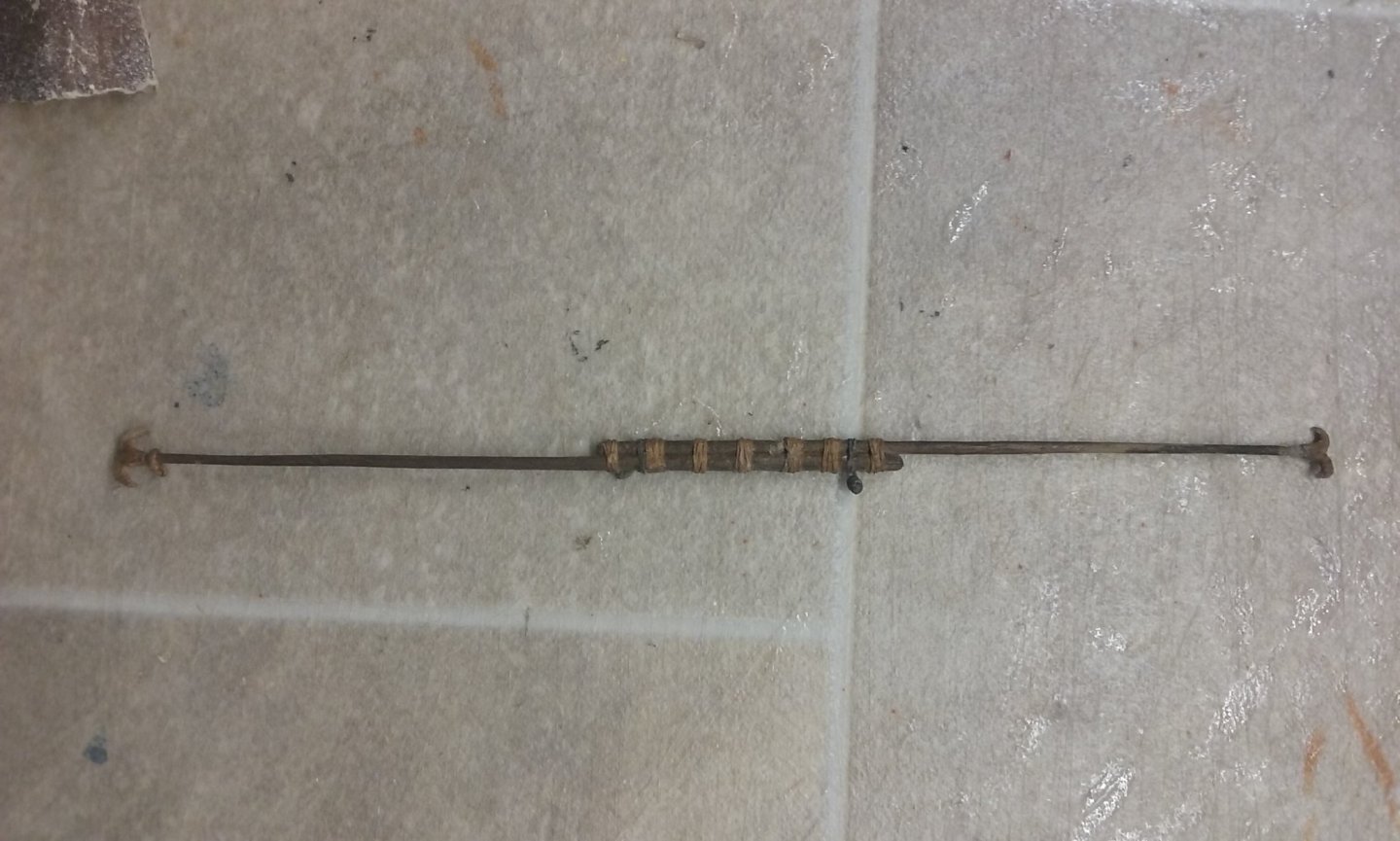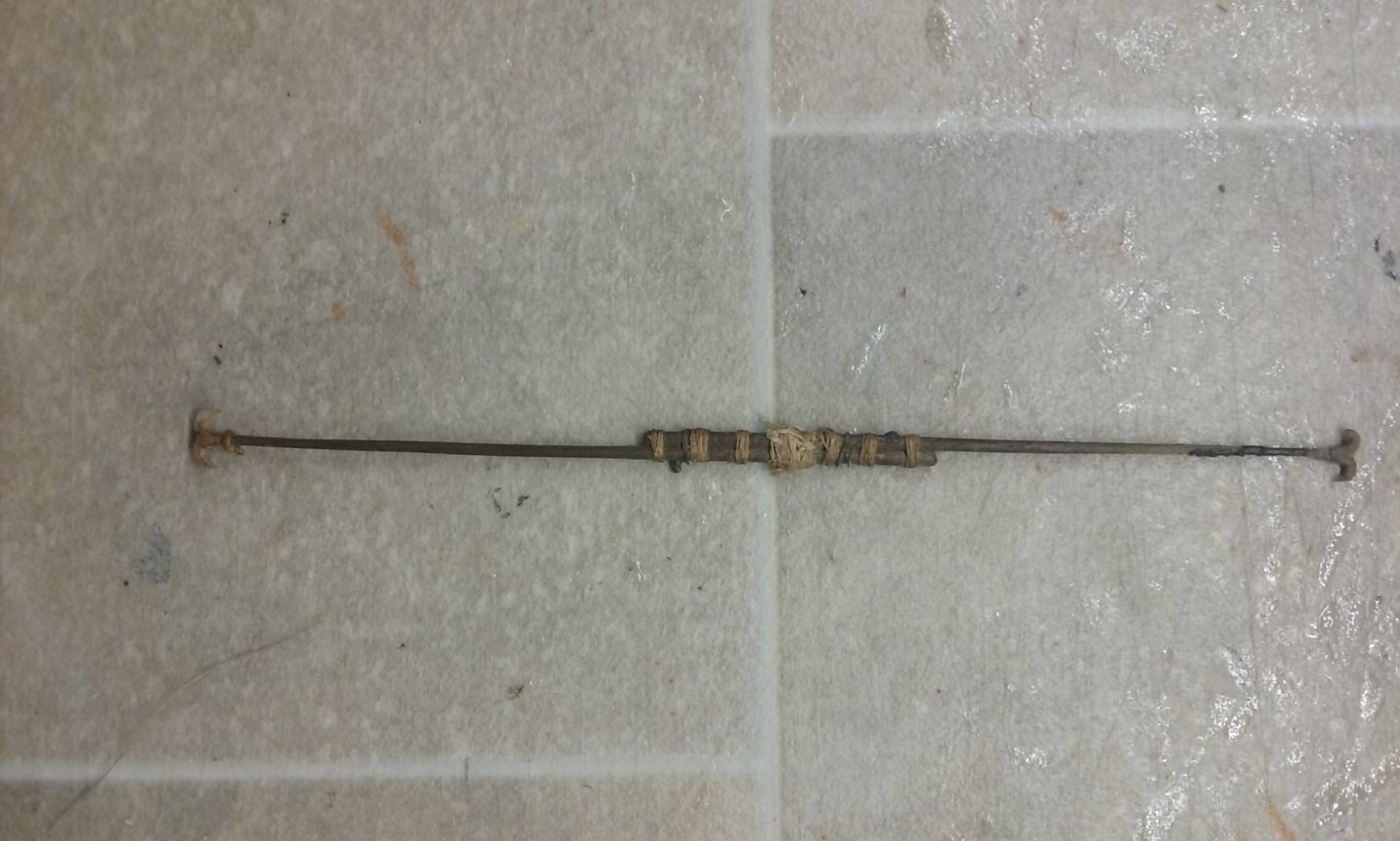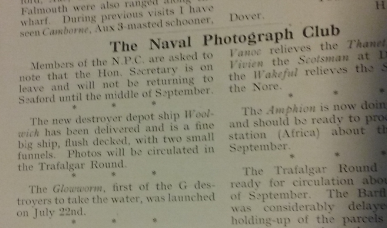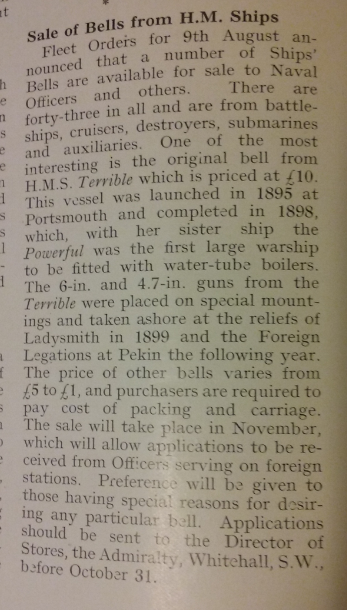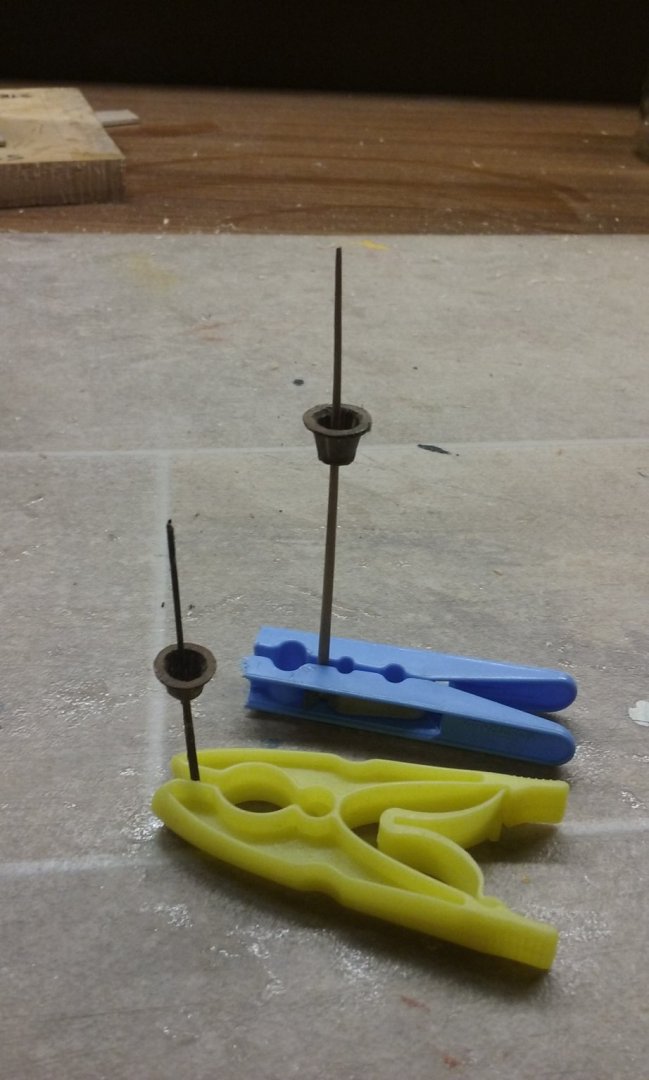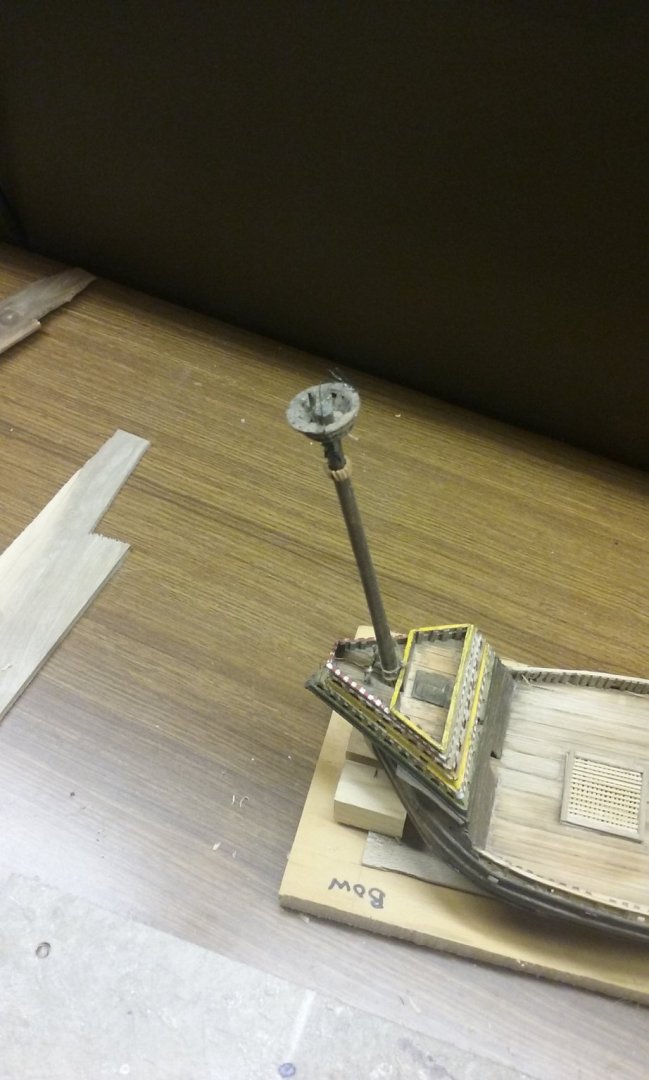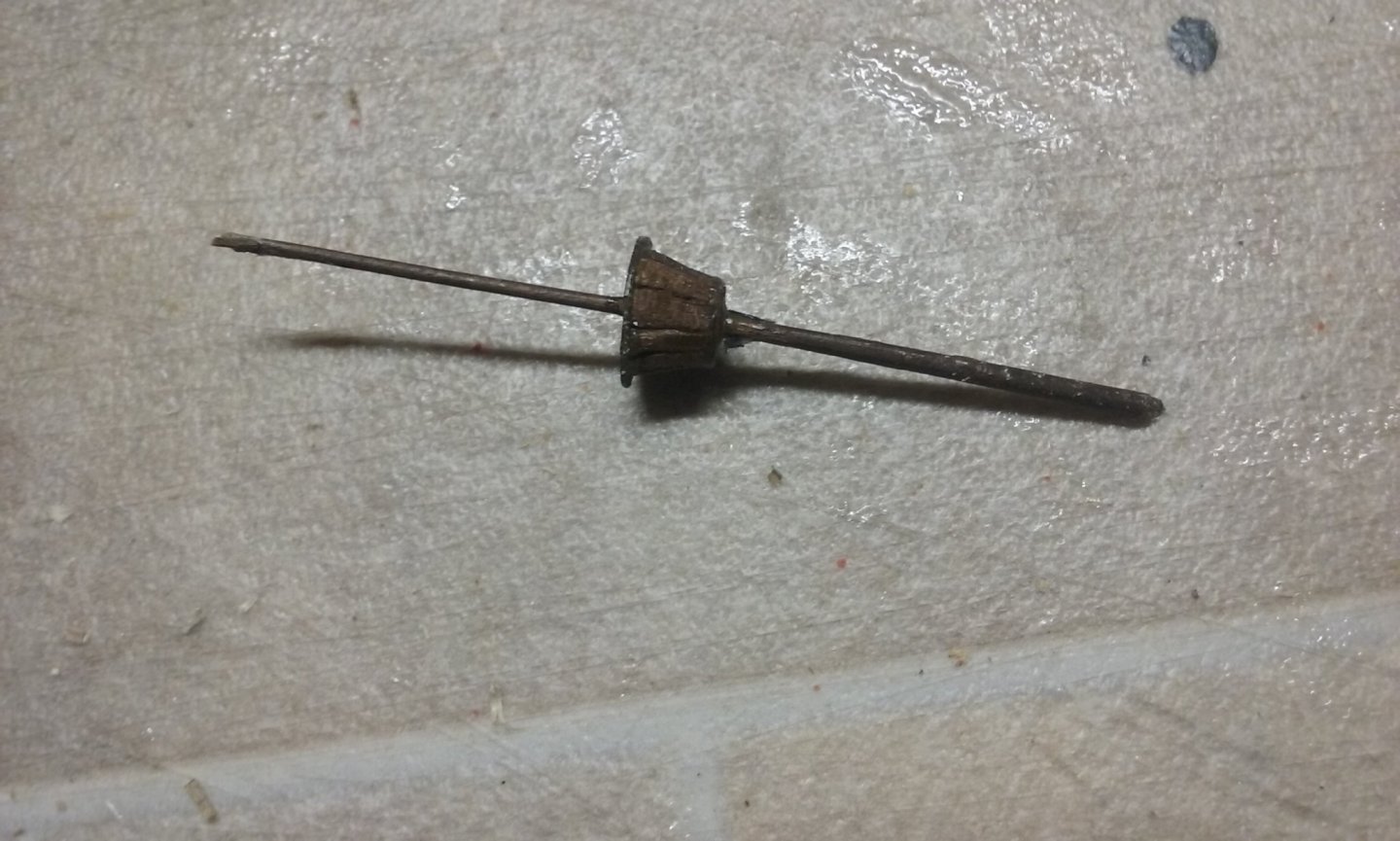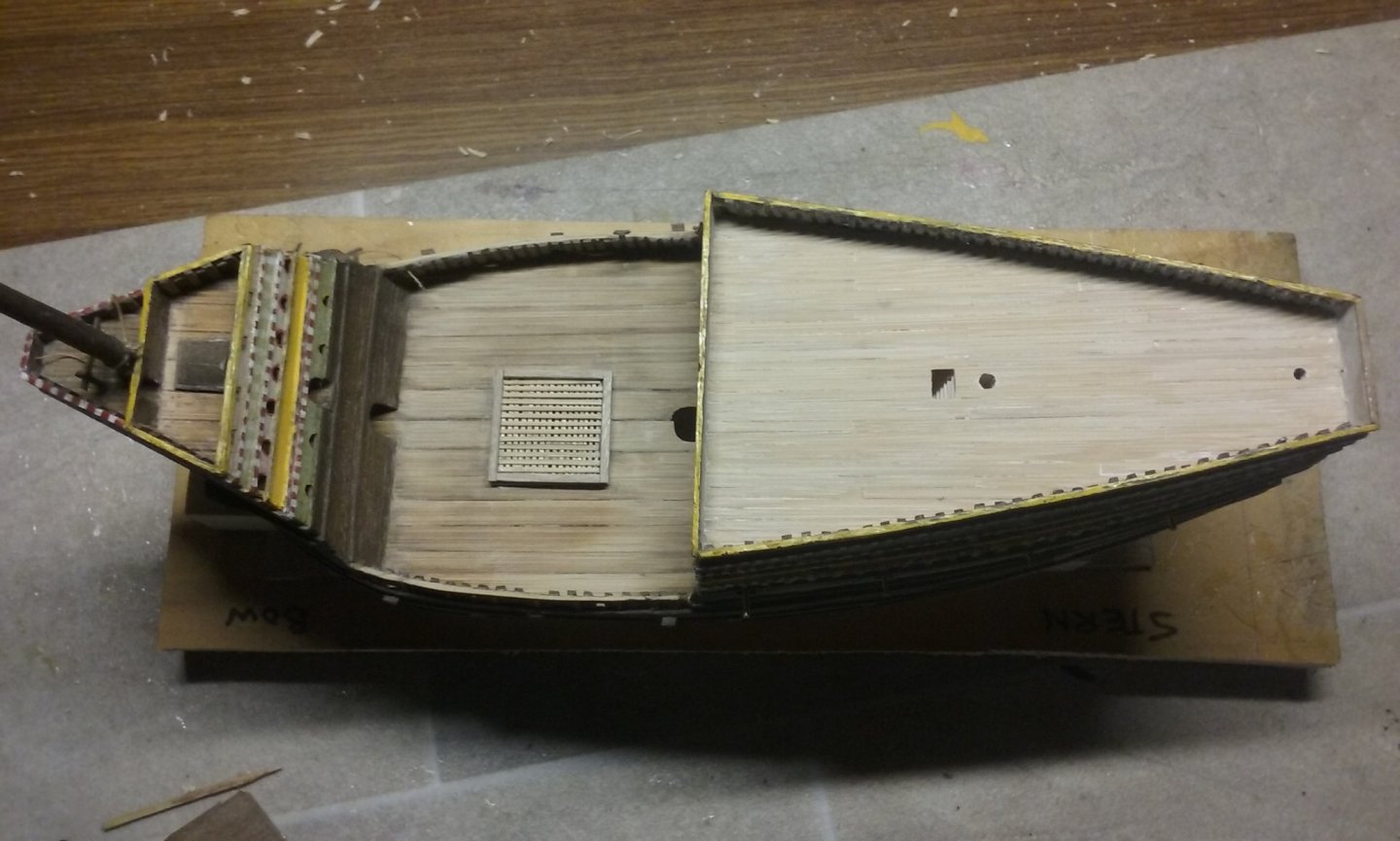-
Posts
7,986 -
Joined
-
Last visited
Content Type
Profiles
Forums
Gallery
Events
Everything posted by Louie da fly
-
Working on the underwater hull so I can start planking. Because I was not only reconstructing the ship but changing the hull shape, there was a fair bit of trial and error involved. I used battens to get the curves as close as I could I've had to build up some of the frames (you can see open space between the frame and the top batten in the photo below). I cut strips of sheet balsa to make the additions, bending them to follow the curve, gluing them in place then trimming them to shape. I haven't been too careful with the glue because it'll all be hidden by the planking. and I had to shave others Almost ready to start planking. Steven
- 740 replies
-
- Tudor
- restoration
-
(and 4 more)
Tagged with:
-
Beautiful job on the oven, Patrick. Very realistic! Steven
- 756 replies
-
- galleon
- golden hind
-
(and 2 more)
Tagged with:
-
Unbelievable. I had no idea the model was so small. That just makes your achievement even more amazing. Such a sad fate, though for such a proud ship. To sail right across the world to be so ignominiously defeated; and the whole of that fleet was either destroyed in the battle, or later at Port Arthur, or captured. Was that the beginning of the end of Tsarist Russia as a world power? Steven
-
Well, I'm almost ready to start planking below the waterline on the Great Harry. I've only ever done one previous pair of garboard strakes, and they weren't all that successful. I've read the tutorials and looked at various builds but I just can't figure out - I know the garboard strake is different widths at different points along its run; but is it the same as the widths of the adjoining planks, (the only difference being that the garboard has one edge that is straight)? For example, if there are (say) 15 strakes between the keel and the other reference point you're measuring to, is the width of the garboard at any given frame 1/15th of the distance measured along that frame ? This has always been a puzzle to me , and I don't want to start planking before I'm sure I know what I'm doing. Thanks, Steven
-
What an amazing build! I'm always interested in weathering on models, but you've taken it to the nth degree! Superb! Steven
-
Beautiful work, Dick. A wonderful build and it's been a pleasure to follow it. Steven
- 263 replies
-
- nave tonda
- round ship
-
(and 2 more)
Tagged with:
-
Yes, not too bad, Pat. I've been chasing down those white marks (which are only obvious in a photograph - almost invisible to the naked eye). Thanks everybody for the likes, by the way. Steven
- 740 replies
-
- Tudor
- restoration
-
(and 4 more)
Tagged with:
-
Blast! Oh well, on to YK-12 Version II. At 1:16 or larger that will involve a whole new set of interesting problems to overcome. How big will it be at that scale? I have to say I really look forward to seeing this one progressing - lots of interesting issues in reconstructing a Byzantine ship as originally built. A break to work on Gros Ventre while you collect your thoughts and get a new look on things would probably be good, as well. Steven
-
I've been agonising over the calcets at the top of the masts, which take the halyard. I'd followed a diagram which showed the calcet as having two sheaves, but try as I might, I couldn't get it to work properly. Any arrangement I was able to come up with was always awkward and overcomplicated. I thought this violates Occam's Razor - the principle that the simplest solution to a problem is usually the best. After looking at many contemporary pictures and also modern photos of lateeners (many of them dhows) I discovered that almost without exception (where it was shown) they certainly had blocks with multiple sheaves, but at the lower end of the halyard. My thanks to Woodrat for his help and advice, which confirmed me in my decision to change the calcets to single-sheaves (which of course meant I had to make new ones!) Also, based on archaeological finds (admittedly from several hundred years later), I changed the connection between the calcet and the mast, from a socket and tenon to a long scarph (known in French as a sifflet or whistle joint - probably because it resembles the angled cut at the top of a tin whistle). I've attached the calcets to the masts with brass pins cut short and filed down. In due course I'll paint them black to resemble iron. And I discovered two more Byzantine single-sheaved blocks! I already had one single-sheaved block from archaeology, but these ones were in considerably better condition and were about double the length. From a 7th-8th century wreck, but so similar to later ones that I'll be using this design in the dromon. The two blocks are identical in design, with a slight difference in length. Here's my reproduction at 1:50 scale of the larger one - yet another opportunity to use my gigantic oversized matchstick. It seems to be a standard feature of Byzantine (and mediaeval Mediterranean) blocks that they didn't have strops around the block to connect them to the rigging, but a hole through the block. Steven
-
And cleaned the forecastle: I used isopropanol and cotton buds (Q tips), and occasionally a scalpel to remove built-up glue when it was too thick. The deck isn't perfectly clean, but it's a lot better than it was. I had to remove the bitts, but it's just as well - it was smothered in old glue. I'll put it back later. Steven
- 740 replies
-
- Tudor
- restoration
-
(and 4 more)
Tagged with:
-
I almost missed this! Another really interesting build. I'll pull up a chair if I may. Steven
-
Mark, I can probably insert wooden pins in the bottoms of the uprights and make holes in the deck to key them into. I'm getting pretty good at that. I've been tidying up the mainyard. It was covered with old bits of cotton from previous incarnation. Also it had been broken and though I was able to put the pieces together the yard was missing a small part so it was thinner at the join than it should have been. I took a leaf out my dromon build and sanded down a remnant of the old timber and mixed it with white glue to make filler. With it I was able to make up the thickness of the mainyard. I had to do two lots of filler to get it up to full thickness. Here it is sanded to shape. And here it is in full, with the surplus cotton removed. Steven
- 740 replies
-
- Tudor
- restoration
-
(and 4 more)
Tagged with:
-
Those are some nice tips on tying blocks, mate. I've bookmarked this page for future reference. A good set of techniques for a very fiddly job. Steven
- 179 replies
-
- santa maria
- mamoli
-
(and 1 more)
Tagged with:
-
No worries. That's just down the road to an Australian . . . Welcome to MSW. As Mark said, start a build log so we can all enjoy your build - and help answer questions, solve problems etc. You're among friends. Steven
-
Welcome, David. Sounds like you've built up a good store of experience which will stand you in good stead. The 1:80 model won't have as much detail (which should be a plus) but will help you find your way around the Endeavour, so when the Big One come along you'll be on fairly familiar ground (albeit rather more comprehensive). Start your build log, and also do a search on other logs for the Endeavour - it's a very popular ship to model, so you ought to be able to pick up a lot of tips from them. Oh, and do read the tutorials on planking; they'll make your job a lot easier. Endeavour has a very bluff bow, and it's apparently a bit of a job to get the planking right. Steven
-
Welcome, Ernie! Copper's all very well, but if you go to the early 16th century Dark Side, you can use lead sheathing! As far as rigging goes, you will pick it up as you go. And if you can't figure something out, just ask one of the friendly Forum members - someone's bound to know. (Oh and deadeyes are so-called because they vaguely resemble a skull - the French call them sheep heads). Have a good look at previous Speedy build logs - you'll probably find many of your questions/problems in your own build have already been encountered and solved by one of our members. Steven
-
Where are you based, Gordon? As you can see I'm in Ballarat, but here are a lot of Aussie members - you might even have one near you! Your idea for the Golden Hind is interesting, to say the least . . . . But nobody's going to rain on your parade and hey, maybe we'll learn something from your experimentation. Steven
-
I hope I'm not intruding on this thread, but I found a couple of articles in "Ships and Ship Models" magazine from September 1935 which in hindsight are very interesting: A mention of the launching of the destroyer HMS Glowworm, which later covered itself in glory against the heavy cruiser Hipper. And another which I found very interesting - I wonder what happened to all those bells, and where they are now? Steven
-

Curtiss P-40B Warhawk by Asat- Airfix- 1/48
Louie da fly replied to ASAT's topic in Non-ship/categorised builds
Unless you're flying a Hawker Harrier. In which case they "viffed" and caused the opposing pilot to overshoot, with predictable results. Speaking of getting hooked on books (not to derail the thread TOO much) I just finished "My Mystery Ships" about the Q-ships of WWI (see https://en.wikipedia.org/wiki/Q-ship) by the most successful of the British Q-ship captains, written about 10 years after the war. Fascinating stuff about a lesser known aspect of the naval service. Steven -
Thanks everyone for the likes. A little more progress. I've recycled the old fighting tops from the fore and main topmasts. Even though I'd made a new fore topmast I was pleased to find that I could salvage the old one - though it was broken into three pieces, they were all intact so I could glue them together again. I'd far prefer to keep as much of the original build as possible rather than replace it with new. I'd also made a new main topmast, but in that case the old one was past saving. So here are the old tops in their new homes. And here's the old fore topmast rebuilt, and the broken off stump still attached to the lower mast. It might be a bit of a problem to hold the two pieces in alignment while I glue it together again, but I'll cross that bridge when I come to it. I won't be doing that until the hull planking is complete, possibly later. The main sanding of the upper deck is done. Only a little tidying up to go. The foredeck is proving a bit of a devil to clean. When I was a kid I slathered white glue everywhere, including on this deck, and the dirt is ingrained in the glue. So I have to carefully remove the glue within a pretty confined space. I've tried slicing it off with a blade, scraping it off, and removing it with isopropanol. None of those techniques is perfect - I'm just having to wing it. I'll probably have to remove the foremast bitts to get at the front of the deck, but there's a great glob of glue at the base of each upright anyway, so it's probably just as well. Steven
- 740 replies
-
- Tudor
- restoration
-
(and 4 more)
Tagged with:
-

Airfix Revenge & Revell Golden Hind Accuracy
Louie da fly replied to Robert Taylor's topic in Nautical/Naval History
Of course, if the Pelican had any sort of decoration to go with her name, it would be a pelican "in her piety" - see http://www.thewestologist.com/symbols/the-symbol-of-self-sacrifice . These representations often looked completely unlike a real pelican - the artists had probably never seen one. According to that great authority Wikipedia: "The legends of self-wounding and the provision of blood may have arisen because of the impression a pelican sometimes gives that it is stabbing itself with its bill. In reality, it often presses this onto its chest to fully empty the pouch. Another possible derivation is the tendency of the bird to rest with its bill on its breast; the Dalmatian pelican has a blood-red pouch in the early breeding season and this may have contributed to the myth." As Michael Caine famously said (assumes cockney accent) "Not many people know vat" Steven -
Thanks for the likes. Druxey, I think it would end up more as a helmet than a hairdo - or like the women's hairstyles of the 60's with all that hairspray; if you flick your finger against them, you'd get a "clunking" sound . . . (not that I ever tried that . . .) Steven
-

Airfix Revenge & Revell Golden Hind Accuracy
Louie da fly replied to Robert Taylor's topic in Nautical/Naval History
Thank you, Thunder. That's something I'd never known before. Chris, that's a beautiful model and very believable (though I love Patrick's as well). Steven
About us
Modelshipworld - Advancing Ship Modeling through Research
SSL Secured
Your security is important for us so this Website is SSL-Secured
NRG Mailing Address
Nautical Research Guild
237 South Lincoln Street
Westmont IL, 60559-1917
Model Ship World ® and the MSW logo are Registered Trademarks, and belong to the Nautical Research Guild (United States Patent and Trademark Office: No. 6,929,264 & No. 6,929,274, registered Dec. 20, 2022)
Helpful Links
About the NRG
If you enjoy building ship models that are historically accurate as well as beautiful, then The Nautical Research Guild (NRG) is just right for you.
The Guild is a non-profit educational organization whose mission is to “Advance Ship Modeling Through Research”. We provide support to our members in their efforts to raise the quality of their model ships.
The Nautical Research Guild has published our world-renowned quarterly magazine, The Nautical Research Journal, since 1955. The pages of the Journal are full of articles by accomplished ship modelers who show you how they create those exquisite details on their models, and by maritime historians who show you the correct details to build. The Journal is available in both print and digital editions. Go to the NRG web site (www.thenrg.org) to download a complimentary digital copy of the Journal. The NRG also publishes plan sets, books and compilations of back issues of the Journal and the former Ships in Scale and Model Ship Builder magazines.


